Japandi living room design brings together the best of Japanese and Scandinavian styles with a refreshing bohemian twist. This style could be the solution to your interior dilemma, merging the calm, clean lines of Japandi decor with the cozy, eclectic charm of boho accents.
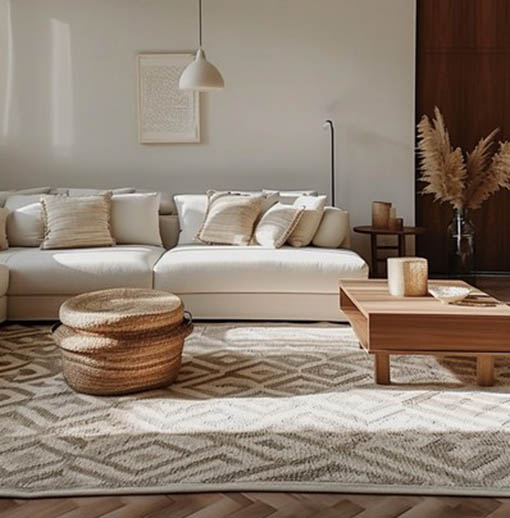
Creating a Japandi living room with boho decor is both uplifting and practical, perfect for those who appreciate minimalism alongside vibrant, personal artistic touches. It offers a harmonious blend that’s both serene and stylish, turning your home into a beautifully curated retreat.
Japandi Living room Goes Boho = Japandi Boho
Are you ready to transform your living room into a stunning, cozy retreat? Japandi Living Room Goes Boho, or Japandi Boho, is the perfect blend of Japanese and Scandinavian styles with a playful bohemian twist! Imagine combining the clean, calming lines of Japandi decor with the vibrant, eclectic charm of boho accents. This style is all about creating a space that’s both serene and full of personality.
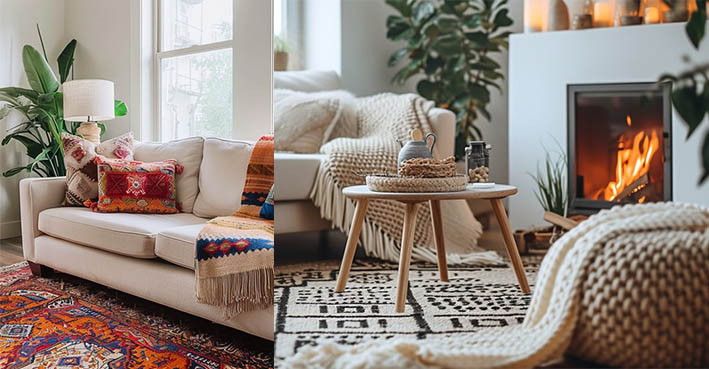
Think of a Japandi Boho living room as your personal haven. The minimalist elements of Japandi, like simple, elegant furniture and natural materials, work seamlessly with boho’s colorful, artistic touches. Add in some plush, textured throw pillows, a beautifully patterned rug, and a touch of greenery, and you’ve got a room that feels both relaxing and lively.
This style is not just about aesthetics; it’s about creating a space where you feel truly at home. It’s uplifting and practical, perfect for those who love a clean look but want to inject some vibrant, personal flair. So go ahead, embrace the Japandi Boho trend and make your living room a beautifully curated retreat that reflects your unique taste and personality!
Japandi Decor for a Boho Interior Enthusiast
For Boho decor lovers, the Japandi living room offers a refreshing blend of minimalism with a hint of eclectic charm.
While Boho is typically characterized by its free-spirited use of textures, colors, and patterns. Japandi’s minimalist approach tones down the chaos without sacrificing the cozy, inviting vibe.
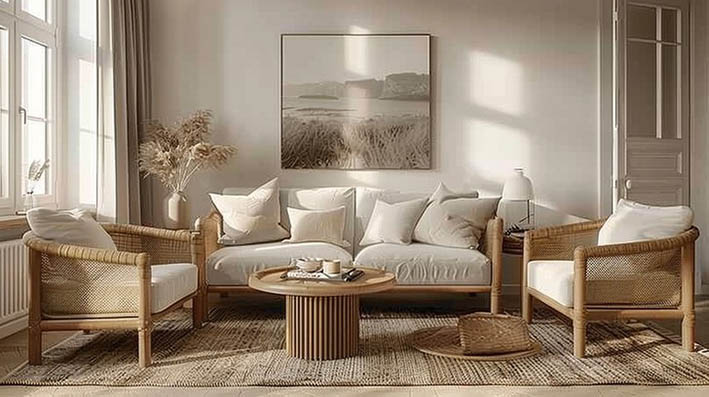
Incorporating Japandi into your Boho-inspired space involves striking the right balance between simplicity and creativity.
Instead of overwhelming the space with patterns and colors, consider using earthy tones and natural materials like wood, bamboo, and stone, which are signature elements of Japandi.
You can still bring in Boho accents through handcrafted decor, soft throws, and woven baskets—just opt for simpler designs. Keep things functional and purposeful, like a macrame wall hanging over a sleek wooden bench or a rattan chair that complements clean lines.
Find Serenity with a Japandi room Divider
A room divider in a Japandi living room can serve as both a functional and decorative element, particularly in open-plan spaces.
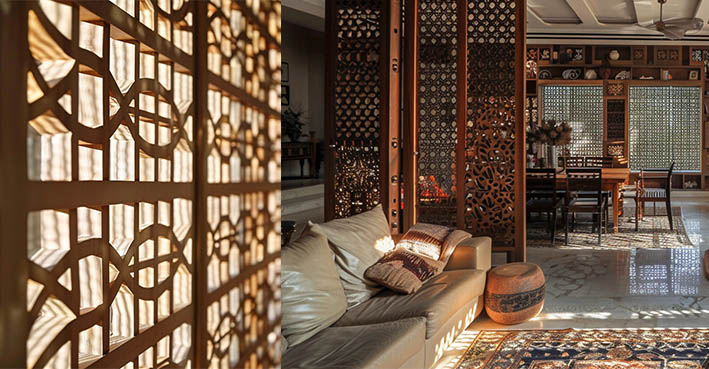
Unlike traditional room dividers, which can be heavy and imposing, Japandi-inspired dividers are lightweight, with clean lines and natural materials. Think of a bamboo screen or a simple wooden partition with open slats that allow light to pass through.
These dividers are perfect for creating serene zones within your living space—perhaps dividing the lounge area from your home office or separating a cozy reading nook.
The key is to maintain an airy, open feel while defining functional spaces. A Japandi divider adds serenity and structure without cluttering the room, allowing for easy flow between areas.
Japandi Living room Boho Decor Ideas
There are many ways to create a Japandi-inspired living room that balances the warm, cozy elements of Scandinavian design with the minimalist aesthetics of Japanese decor.
Start by choosing neutral tones like beige, gray, and soft whites for the walls and large furniture. This neutral backdrop creates a sense of calm and spaciousness, typical of Japandi interiors.
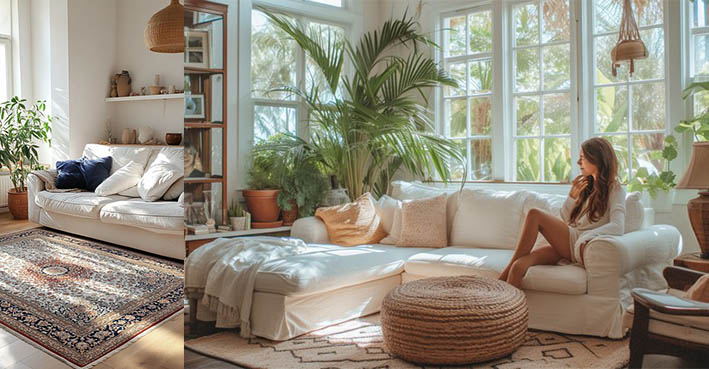
Next, incorporate natural textures like wooden furniture, linen cushions, and woven rugs.
Adding greenery—such as bonsai trees, potted plants, or dried pampas grass—can infuse the space with life while sticking to the minimalist ethos.
When selecting decor, keep it simple and functional. Opt for handcrafted ceramics, low wooden tables, and floor cushions that reflect both comfort and craftsmanship.
Japandi Living room Furnitures and Boho Decor
Furniture in a Japandi living room should be understated yet functional. Low-profile sofas, sleek wooden coffee tables, and open shelving units are ideal choices.
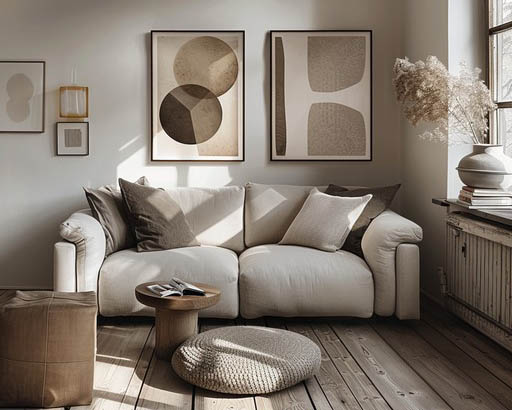
The emphasis is on simplicity, so avoid furniture with overly ornate details or excessive embellishments. Instead, choose pieces made from natural materials such as oak, walnut, or bamboo, which blend well with the serene Japandi aesthetic.
Decor should be minimal but intentional. Think handmade pottery, woven baskets, or simple ceramic vases with single stems. Wall art can be a mix of Japanese prints or abstract Scandinavian designs, but avoid cluttering the walls.
The goal is to create a space that feels calm, balanced, and effortlessly stylish.
Japandi Living room Boho Style
The Japandi style is all about the fusion of two design philosophies:
The warm coziness of Scandinavian hygge and the minimalist beauty of Japanese wabi-sabi. Together, they form a living room aesthetic that is tranquil yet warm, minimal yet inviting. This style embraces “less is more” while maintaining a deep connection to nature and craftsmanship.
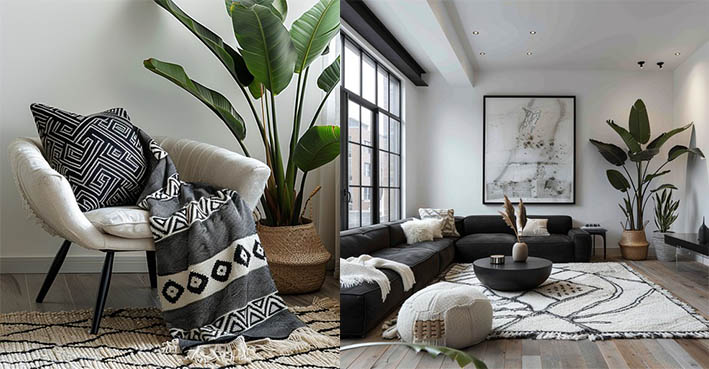
The beauty of Japandi living rooms lies in their ability to balance functionality with elegance.
Furniture is streamlined, with clean lines and neutral palettes. Nature-inspired materials like wood, stone, and linen are prominent, and decor is kept simple but thoughtful. The result is a harmonious living space that promotes relaxation and mindful living.
Japandi Living room Rug for Cold Feet
A rug is essential for adding warmth and texture to a Japandi living room, especially for those cold feet on chilly mornings.
Look for rugs made from natural materials like wool, jute, or cotton, which align with the eco-friendly and earthy aesthetics of Japandi style. A neutral or muted color palette works best—think light beige, soft gray, or warm brown.
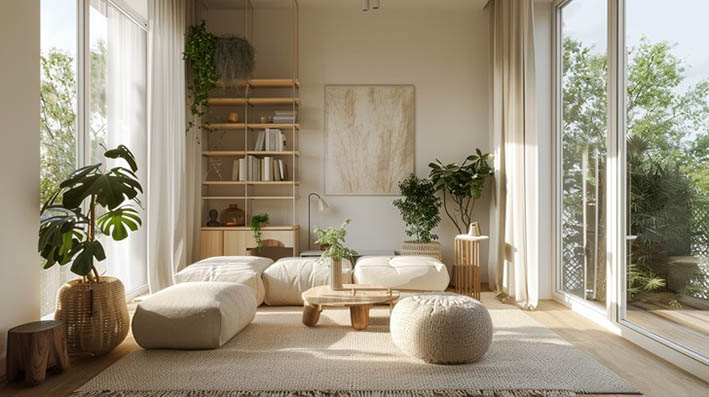
When choosing a design, opt for simple, subtle patterns or solid colors that won’t overwhelm the space.
The rug should complement, not compete with, the minimalist decor. A thick, cozy wool rug under a low wooden table can enhance the feeling of warmth and comfort, creating a perfect grounding element for your Japandi living room.
Japandi Living room Lightening
Lighting in a Japandi living room is subtle, soft, and functional.
Natural light plays a significant role, so large windows or sheer curtains can help flood the space with sunlight during the day. For artificial lighting, stick to simple, minimal designs that complement the overall aesthetic.
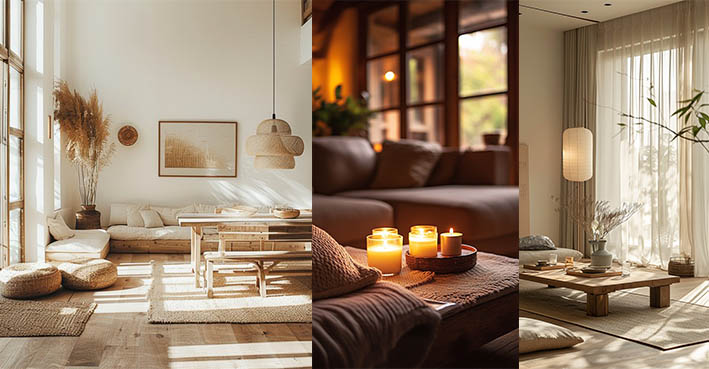
Pendant lights with paper or bamboo shades, recessed lighting, and sleek floor lamps with wooden accents are all excellent choices.
The goal is to create a warm, inviting atmosphere with soft, diffused light. Avoid harsh overhead lighting; instead, opt for layered lighting that can be adjusted to different moods, enhancing the serene ambiance of your living room.
Another Japandi Room for You
Once you’ve mastered the Japandi living room, you might want to extend this calming, minimalist aesthetic to other areas of your home. The beauty of Japandi design lies in its versatility—it can easily transition from living rooms to bedrooms, kitchens, and bathrooms, creating a cohesive style throughout your home.
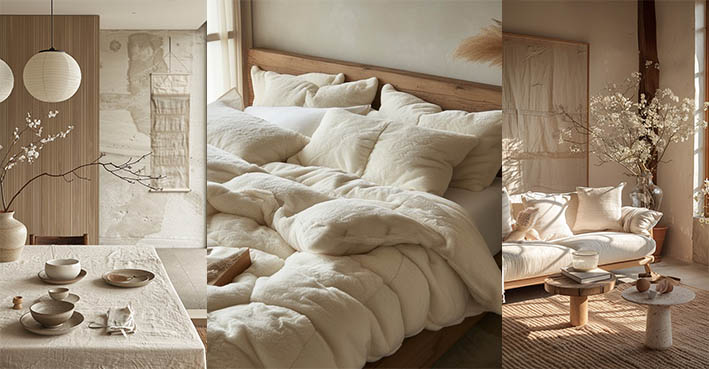
A Japandi bedroom might feature a low platform bed with natural linen bedding, or a simple, elegant writing desk made from light wood.
You could also bring Japandi into your dining space with a minimalistic wooden table, paired with sleek chairs and handmade ceramic dinnerware.
The possibilities are endless, and the calming effect of Japandi design is sure to bring harmony to every corner of your home.
A Japandi Bedroom where Boho Decor Doesn´t Sleep
Japandi and Boho styles come together beautifully in the bedroom.
To create a space where the two meet, focus on using neutral tones and minimalist furniture as the foundation, while layering in textures and handcrafted Boho decor for warmth. Think of a low wooden bedframe, adorned with soft linen bedding in off-white or beige tones, accompanied by a macrame wall hanging or woven throw.
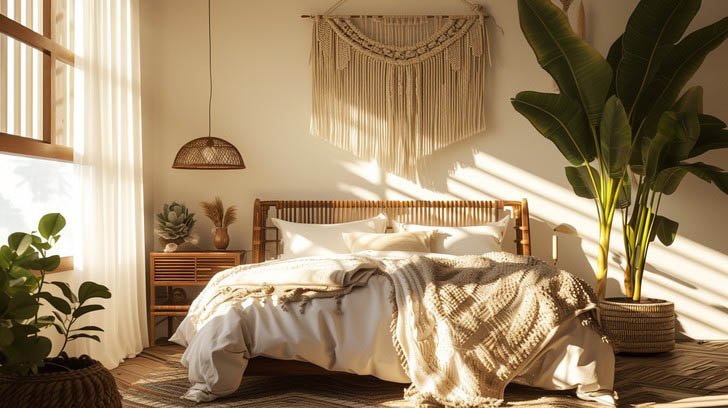
For storage, go for simple wooden dressers or floating shelves, but don’t be afraid to add a touch of Boho with a wicker basket or handwoven rug at the foot of the bed. This combination of Japandi’s simplicity and Boho’s creative flair results in a bedroom that’s peaceful yet personal.
Cooking in a Japandi Kitchen for Bohemians
A Japandi kitchen for Bohemian souls is a place where functionality meets free-spirited design.
Keep the core of the kitchen clean and minimal, with smooth wooden cabinets, open shelving, and countertops made of natural stone or wood.
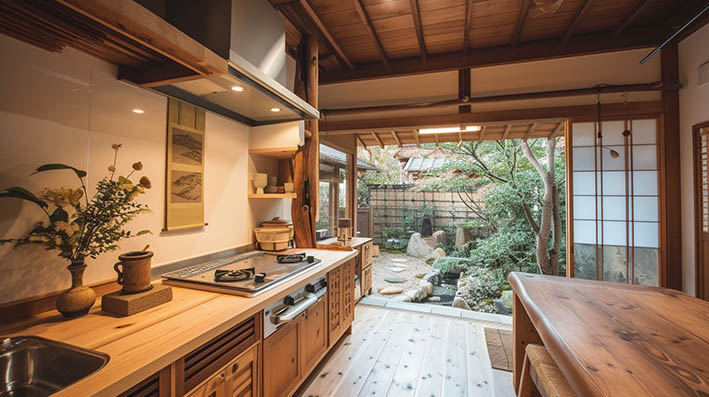
Add Boho flair through woven baskets, handmade pottery, and hanging plants that introduce a burst of life and texture to the space.
The Japandi approach ensures that everything has its place, while the Boho touch brings in creativity with personalized touches like colorful ceramic dishes or a vintage-inspired rug. It’s a perfect blend for those who love cooking in a space that feels orderly yet full of personality.
Japandi Bathroom in a Clean Boho Decor Style
Transform your bathroom into a serene retreat by blending Japandi’s clean lines with Boho’s warmth and texture.
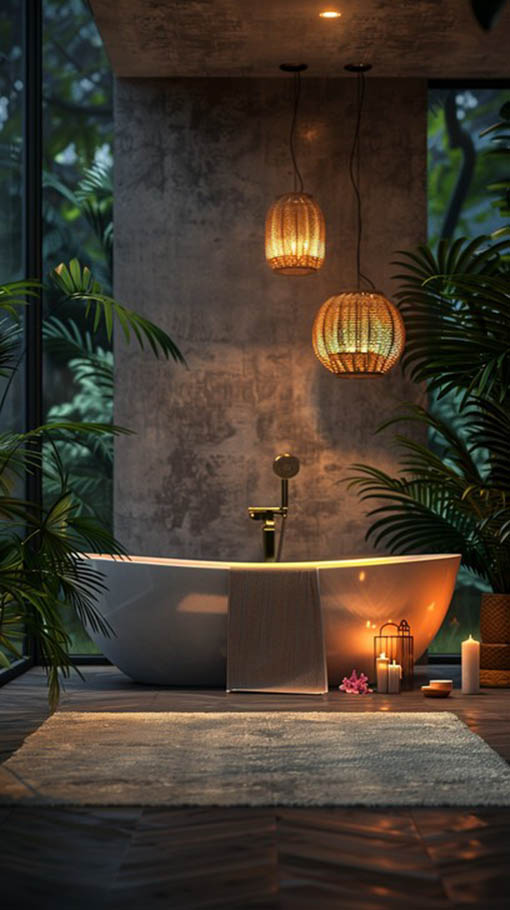
Use natural stone, bamboo, or light wood for bathroom fixtures and furnishings. The neutral color palette of Japandi—soft whites, grays, and beige—will help to create a calming atmosphere.
To add a Boho twist, introduce artisanal pieces like a handwoven basket for towels, a colorful, patterned bath mat, or a macrame plant hanger. Keep decorations minimal, but ensure every piece feels thoughtful and purposeful, turning your bathroom into a peaceful, spa-like sanctuary.
Japan Culture Facts vs Scandi Related to Interior design
The synergy between Japanese and Scandinavian design lies in their shared cultural values.
Japanese interior design is deeply influenced by the concept of wabi-sabi, which embraces imperfections and finds beauty in simplicity. Scandinavian design, on the other hand, is built around the idea of hygge—creating a cozy, comfortable space that promotes well-being.
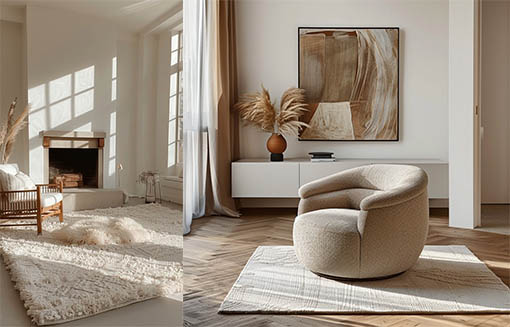
Both cultures emphasize natural materials, minimalism, and a strong connection to nature.
Where they differ is in the finer details: Japanese design often incorporates traditional craftsmanship and asymmetry, while Scandinavian design favors practicality, symmetry, and functionality.
The Japandi style harmonizes these differences, blending the two seamlessly into a unified aesthetic.
Frequently Asked Questions
What are the key elements of a Japandi living room?
A Japandi living room should include neutral colors, natural materials like wood and stone, minimalist furniture, and functional decor. The style focuses on simplicity, comfort, and a strong connection to nature.
Can Japandi work with other design styles like Boho?
Yes! Japandi can work beautifully with Boho, as both styles appreciate natural elements. You can combine Japandi’s clean lines with Boho’s textured decor to create a unique, harmonious space.
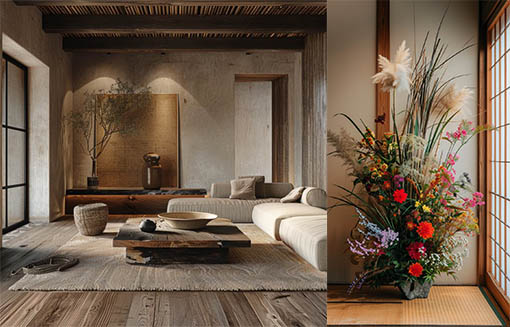
What kind of lighting works best in a Japandi living room?
Opt for soft, diffused lighting with natural materials like paper or bamboo. Pendant lights, recessed lighting, and minimalist floor lamps work well in creating a warm and inviting ambiance.
Conclusion
The Japandi living room offers a unique balance between minimalism and warmth, providing a serene yet stylish space.
Whether you’re a Boho enthusiast looking to add structure to your decor or simply drawn to the calming vibes of Japandi, this style brings a harmonious blend of Japanese simplicity and Scandinavian coziness.

By incorporating natural materials, neutral tones, and purposeful design elements, you can create a living space that feels both grounded and welcoming—perfect for unwinding and finding peace in simplicity.
Now it´s time for you to create your own unique Japandi Living room 🙂

